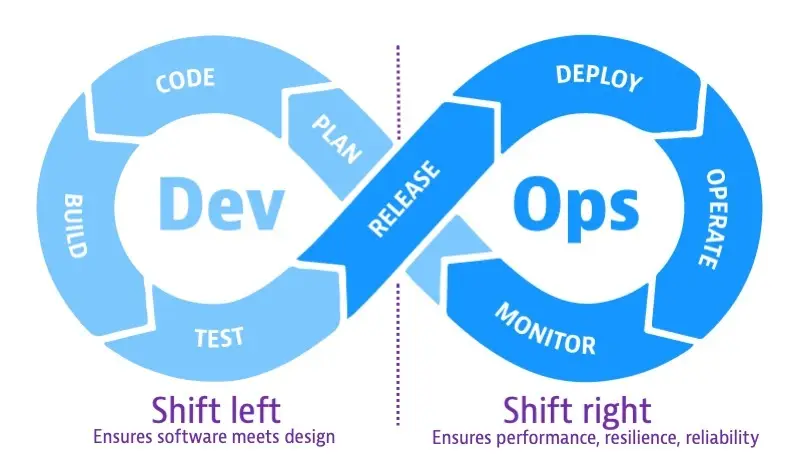Shift-Left Shift-Right Testing an early Quality Assurance in Software Development
 Mohammad Zubair
Mohammad Zubair
Shift-Left Testing:
Shift-Left Testing is a software testing approach that emphasizes moving testing activities earlier in the software development lifecycle, typically to the left on a timeline or project schedule. The goal is to detect and address issues as early as possible in the development process, ideally before they propagate into later, more expensive stages of development. This proactive approach helps in delivering higher-quality software, reducing costs, and accelerating the development cycle. Below, I'll explain Shift-Left Testing in more detail:
Key Principles and Practices of Shift-Left Testing:
Shift from Post-Development to Pre-Development:
- In traditional testing approaches, testing often occurs after the development phase. Shift-Left encourages a move toward testing earlier in the development process, such as during coding and design.
Early Validation of Requirements:
- One of the primary objectives of Shift-Left is to validate requirements and specifications as early as possible. This involves closely collaborating with stakeholders and developers to ensure that the requirements are clear, complete, and testable.
Collaboration and Communication:
- Effective communication and collaboration between different project stakeholders, including developers, testers, and business analysts, are essential for Shift-Left Testing. This ensures everyone is on the same page regarding requirements and testing objectives.
Unit Testing:
- Developers write and execute unit tests for individual code components, ensuring that these components work as intended. Unit tests are typically automated and focus on specific functions or modules.
Static Analysis Tools:
- The use of static code analysis tools is common in Shift-Left Testing. These tools analyze the source code for potential issues such as coding standards violations, code smells, and potential vulnerabilities.
Continuous Integration (CI):
- Integrating automated testing into the CI process allows for immediate feedback on code changes. With each code commit, automated tests are executed to identify defects early.
Early Defect Detection:
- Shift-Left aims to detect defects at the earliest possible stage, often during development. This makes it easier and less costly to fix issues when they are identified early.
Advantages of Shift-Left Testing:
Reduced Costs: Early issue detection and resolution result in cost savings. Fixing defects in the development phase is generally less expensive than addressing them in later stages or after the software is in production.
Faster Development: By identifying and addressing issues promptly, Shift-Left helps maintain a faster development cycle, leading to quicker time-to-market for software products.
Improved Software Quality: Early testing and validation of requirements lead to improved software quality and a better user experience.
Enhanced Collaboration: Shift-Left encourages collaboration and communication among team members and stakeholders, fostering a shared understanding of project goals.
Risk Mitigation: Identifying and mitigating risks early reduces the likelihood of costly issues emerging later in the development process or after deployment.
Challenges of Shift-Left Testing:
Resource Allocation: Shifting left often requires investing more resources in the early stages of development, such as additional testing personnel, tools, and training.
Knowledge and Skill Set: Developers and testers need to acquire the knowledge and skills to perform effective unit testing, code analysis, and collaboration.
Time Constraints: In Agile and fast-paced development environments, it can be challenging to allocate sufficient time for comprehensive Shift-Left practices.
Integration with Existing Processes: Introducing Shift-Left into existing development processes may require adjustments and buy-in from the entire development team.
Shift-Right Testing:
Shift-Right Testing is an approach to software testing that involves moving some testing activities to later stages of the software development lifecycle, often into the production or post-release environment. The term "shift-right" implies moving testing activities to the right on the timeline, towards the later stages of development. This approach aims to continuously monitor and improve software quality by gathering real-world data, identifying issues, and responding to incidents as they occur. Below, I'll explain Shift-Right Testing in more detail:
Key Principles and Practices of Shift-Right Testing:
Post-Release Testing:
- Unlike traditional testing, which mostly occurs before software release, Shift-Right Testing focuses on post-release testing. It is performed in the live, production environment.
Monitoring and Observability:
- Implementing robust monitoring and observability tools is crucial. These tools track various aspects of application performance, including response times, error rates, and resource usage.
User Feedback and Experience:
- User feedback and experience are key components. Shift-Right often involves gathering feedback from end-users and stakeholders to understand how the software performs in real-world scenarios.
A/B Testing and Experimentation:
- A/B testing is common in Shift-Right Testing, where two or more versions of a feature are compared to determine which performs better in terms of user engagement or other defined metrics.
Incident Response and Management:
- A significant aspect of Shift-Right Testing is incident response. When issues are detected in production, a structured process is followed to identify, prioritize, and resolve them quickly.
Security and Compliance Monitoring:
- Continuously monitor the software for security vulnerabilities and compliance with industry standards and regulations. Security testing and vulnerability assessments play a role in this.
Feedback Loop to Development:
- Valuable feedback from Shift-Right activities is provided to the development team. This information informs future development efforts and improvements.
Examples of Shift-Right Testing:
A/B Testing: Running two versions of a feature in production to gather user feedback and determine which version performs better.
Real-time Monitoring: Implementing real-time monitoring and alerting systems to detect anomalies and incidents in the production environment.
User Experience Testing: Gathering feedback from users about their experiences with the software and using it to make improvements.
Security Testing in Production: Continuously scanning the software for security vulnerabilities and responding to potential threats as they arise.
Incident Response: Rapidly responding to and resolving production incidents to minimize downtime and user impact.
Load Testing in Production: Performing load testing in the live environment to assess how the software performs under real-world loads.
Performance Optimization: Identifying performance bottlenecks and opportunities for optimization in the production environment.
Advantages of Shift-Right Testing:
Real-World Validation: Shift-Right Testing provides real-world data and user feedback that can lead to more informed decision-making and product improvements.
Incident Mitigation: It allows for quick identification and resolution of incidents and issues in the production environment, minimizing disruptions.
User-Centric Approach: By focusing on user feedback and experience, Shift-Right Testing ensures that software aligns with user expectations and needs.
Continuous Improvement: The feedback loop from Shift-Right activities feeds into the development process, driving ongoing improvements and optimizations.
Challenges of Shift-Right Testing:
Resource and Tools: Implementing Shift-Right may require investments in monitoring tools, user feedback mechanisms, and incident response processes.
Data Privacy and Compliance: Handling user data in production testing and ensuring compliance with data privacy regulations can be challenging.
Complexity: Managing multiple versions or feature flags for A/B testing can increase complexity in the production environment.
Shift-Left Testing focuses on early issue detection, improving software quality, and cost savings, while Shift-Right Testing complements it by continuously monitoring, responding to incidents, and using user feedback and real-world data to enhance software quality and user satisfaction, making them valuable components of modern software development practices.
Subscribe to my newsletter
Read articles from Mohammad Zubair directly inside your inbox. Subscribe to the newsletter, and don't miss out.
Written by

Mohammad Zubair
Mohammad Zubair
I'm a professional Software Test Engineer with two years of experience in software testing. Proficient in developing and executing automated test scripts, performing manual testing, and identifying and reporting defects.